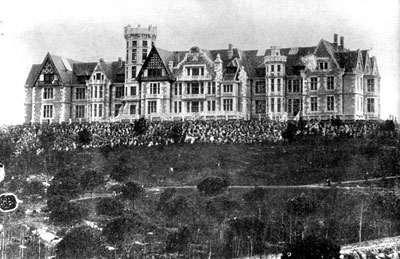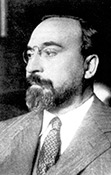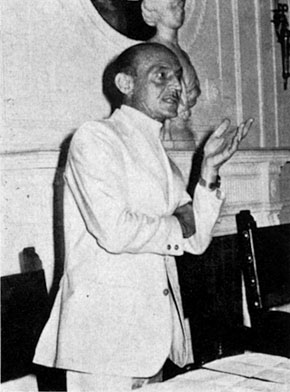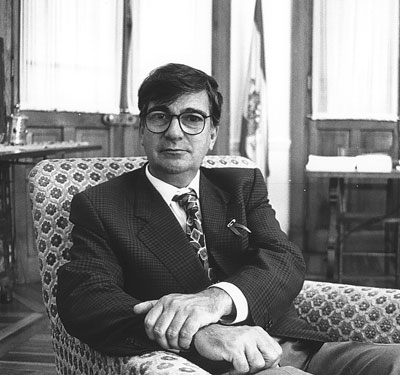History
1908 - 1936
In January 1908, Santander City Council agreed to donate La Magdalena peninsula to his majesty King Alfonso XIII to build a publicly funded Royal Palace.
 The council organised a competition to select the architectural design for the building, which was won by local architects Gonzalo Bringas and Javier González Riancho. The monarchs took possession of the palace on 4th August 1913, having been furnished and decorated under the supervision of Queen Victoria Eugenia.
The council organised a competition to select the architectural design for the building, which was won by local architects Gonzalo Bringas and Javier González Riancho. The monarchs took possession of the palace on 4th August 1913, having been furnished and decorated under the supervision of Queen Victoria Eugenia.
.
 The palace was the summer residence of the monarchy for 17 years. After the 2nd Republic was proclaimed in April 1931, the palace was closed. In the following year, the government approved a proposal by the Minister for Public Education, Fernando de los Ríos, and decreed the foundation of the Santander International Summer University. The courses would be based in La Magdalena Palace, with historian and philologist Ramón Menéndez Pidal being appointed vice-chancellor. The same decree appointed poet and lecturer Pedro Salinas as secretary general, who was the true inspiration behind this new unique university institution.
The palace was the summer residence of the monarchy for 17 years. After the 2nd Republic was proclaimed in April 1931, the palace was closed. In the following year, the government approved a proposal by the Minister for Public Education, Fernando de los Ríos, and decreed the foundation of the Santander International Summer University. The courses would be based in La Magdalena Palace, with historian and philologist Ramón Menéndez Pidal being appointed vice-chancellor. The same decree appointed poet and lecturer Pedro Salinas as secretary general, who was the true inspiration behind this new unique university institution.
A wide range of summer courses on important topics in the period were organised at the palace between 1933 and 1936, as well as Spanish language and literature courses for foreigners, which had been taught by the Menéndez Pelayo Society since 1926. In addition, the programmes at the Postgraduate Medical Institute taught at the Valdecilla Health Institute were also offered.
1945 - 1974
The International University’s activities were suspended due to the Spanish Civil War. In the summer of 1938, the Ministry of National Education commissioned the Menéndez Pelayo Society to organise language and literature courses for foreigners. At the behest of the Minister of National Education, José Ibáñez Martín, the government passed a degree in 1945 creating the Universidad Internacional Menéndez Pelayo in Santander, based at the former San Rafael Hospital. The new institution started its activities in 1947, mainly at the Monte Corbán diocesan seminary, as well as other education centres in the city.
In the summer of 1949, the university returned to its main headquarters in La Magdalena Palace thanks to the gracious donation of His Royal Highness the Count of Barcelona, Juan de Borbón.
 The first vice-chancellor was Ciriaco Pérez Bustamante, who continued the three principal academic activities of the university: courses on contemporary issues and the humanities, language and literature courses for foreigners, and medical courses at the Valdecilla Health Institute.
The first vice-chancellor was Ciriaco Pérez Bustamante, who continued the three principal academic activities of the university: courses on contemporary issues and the humanities, language and literature courses for foreigners, and medical courses at the Valdecilla Health Institute.
Three individuals (Pedro Laín Entralgo, Rafael Lapesa and Emilio Díaz Caneja) spearheaded and reflected the intellectual and scientific quality of the long list of lecturers who taught on the ever more diversified and specialised courses, and established the general programme of the educational institution.
Given the constant expansion of the university’s activities, a campus was created at Las Llamas, with buildings that housed lecture halls, and hosting and residential services for foreign students on the Spanish language and literature courses, as well as those enrolled for the humanities courses. Professor Pérez Bustamante was succeeded as vice-chancellor by Florentino Pérez Embid in 1968.
1975 - 1982
During this period, the UIMP (initials that became the common acronym for the university over time) was led by Francisco Ynduráin (1974-1980) and Raúl Morodo (1980-1983). These eight years saw the university consolidate its reputation as a renowned higher education enterprise, able to evolve alongside the changes in Spanish society during a complex period of political transition. A poet and lecturer who knew the university well defined it as a true ‘island of liberty’.
Veneration and respect for knowledge in the humanities and science lay at the core of the institution which, from its early beginnings, aimed to ‘meet the equally desirable and essential needs for modern cultural instruction: a focus on universal human requirements that should spark the sensitive consciousness of all, and a skilful approach to clarifying carefully defined technical problems that represent positive progress in a special discipline’. The number and specialisation of scheduled courses expanded year after year, with a view to including new topics from the different fields of social science, humanities, experimental science and technology, as well as the requirements and expectations of students from different university faculties.
In turn, cultural activities in music, theatre, poetry recitals, cinema, etc. were expanded, alongside large festivals in the Plaza Porticada, all of which were highly regarded by overseas students. Furthermore, the creation of the University of Cantabria (1972) ensured the buildings on Las Llamas campus were put to better use through sharing facilities and both institutions using them throughout the year.
1983 –The Present

This was a long intense period of activity at the university. The different vice-chancellors over this time were: Santiago Roldán López (1983-1989), Ernest Lluch Martín (1989-1995), José Luís García Delgado (1995-2004), Luciano Parejo Alfonso (2005-2006), Salvador Ordóñez Delgado (2006-2012), César Nombela Cano (2012- 2017), and Emilio Lora-Tamayo D’Ocon (2017-2018). Since December 2018, María Luz Morán Calvo Sotelo, a full tenured professor in sociology at the Complutense University, has been vice-chancellor.
The UIMP has undergone notable changes in its structure, facilities and operation over the last three decades. In addition to the emblematic headquarters at La Magdalena, other sites have opened across Spain: Barcelona, Cartagena, La Coruña, Cuenca, Granada, La Línea de La Concepción, the Pyrenees (Huesca), Santa Cruz de Tenerife, Seville and Valencia. Moreover, another Santander campus was opened at Las Llamas, in collaboration with the University of Cantabria, where the Torres Quevedo Residence and several teaching and services blocks have been built. The different sites offer an important and increasing selection of activities at the UIMP.
Renovation work on the palace and stable block at La Magdalena began in 1993. The classrooms, bedrooms and service areas were renovated; and new support systems and teams for teaching and for improving administration were introduced. After the work was completed, the site was officially opened on 14th June 1995 by Their Royal Highnesses, King Juan Carlos and Queen Sofía.
The university’s academic programme incorporated new types of courses and activities during this period:
- The masterclasses and ‘author and work’ courses, led by a sole lecturer
- The schools, designed as highly academic seminars in fields such as social anthropology, molecular biology, philosophy of science, materials engineering, neurology, nutrition, psychology, theology, etc.
- The ‘Rector Jordá’ Marine Course, in collaboration with the University of Cantabria and the Santander Port Authority, located at La Magdalena lighthouse and later transformed into the CITAP (International Centre for Port Technology and Administration)
- The Ortega y Gasset Programme for introducing university studies to students who are completing their high school period with exceptional grades.
Two new activities have taken on huge importance in the last decade: the language courses (Spanish as a Foreign Language and Immersion in English) and an expanding catalogues of UIMP-specific and official postgraduate qualifications, established in collaboration with the CSIC national research council, the Bank of Spain and other institutions.
The university published its new statute in 2002, with a view to better defining its objectives, governance structure and operation. The UIMP became an independent institution within the Spanish Central Administration.
On the institutional front, the establishment of the General Foundation of the UIMP should be highlighted. It was created to collaborate in and support university activities, and was recently incorporated into the Foundation for International Outreach at Spanish Universities (universidad.es).
Since 1987, the university has sponsored and organised the ‘International Menéndez Pelayo Award’ on an annual basis. The award was established thanks to the patronage of Santander-Mexican Eulalio Ferrer, who sadly passed away in March 2009. The award aims to highlight the literary or scientific work of individuals who have had humanistic impact, such as the work produced by Marcelino Menéndez Pelayo. It is aimed at Spanish- or Portuguese-speaking nations, and candidates are put forward by universities, academies and other institutions or centres with ties to culture.





